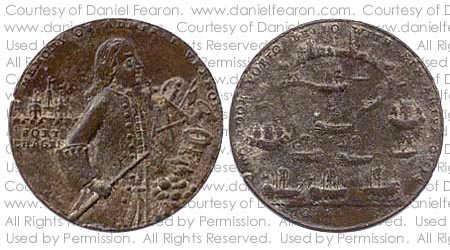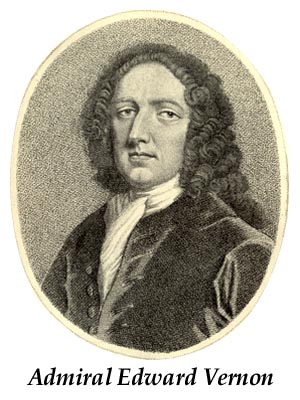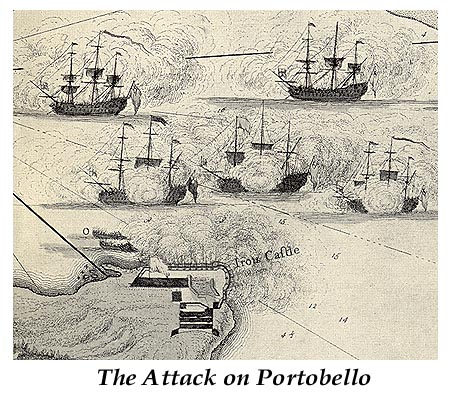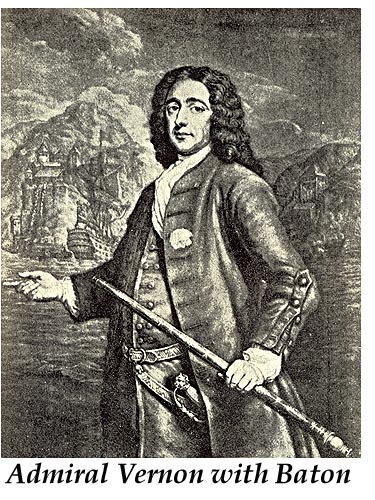Admiral Vernon Medals Catalog (VN)
Catálogo de las Medallas Conmemorativas del Almirante Vernon

|
Below is a catalog or list of all known Admiral Vernon medals. Most are related to Panama (either Portobello or Fort Chagre), but a few are not. There are approximately 270 different types. While this catalog will be complete to the best of my knowledge, many medals lack an image or illustration. If you have an image or can make a rubbing of a medal for which I do not have an image, please me. Likewise, please e-mail me once the catalog is complete if you know of any varieties of Admiral Vernon medals which are not listed in this catalog. Another resource available is the Admiral Vernon Medal Grading Guide to help you determine the condition of an Admiral Vernon medal.
History
In the 1730's the Spanish ruled from Florida and California south to the southern-most tip of South America. The English were limited on the mainland to north of Florida and were not allowed to trade with the Spanish colonies. Tensions grew between the English and the Spanish. A sea-captain by the name of Jenkin accused the Spanish of illegally boarding his ship and cutting off his ear when he resisted. In one account he threw the ear on a table in the presence of Parliament. Thus started the "War of Jenkin's Ear". Most English viewed the Spanish fortifications in the New World with awe and respect, especially Portobello and Cartagena. Portobello (sometimes written as two words - Porto Bello) was a fortified port (in what is now Panama) where Spanish gold and silver mined from Peru and elsewhere was collected and shipped. The English had attempted to take it in 1726 with twenty ships and failed. Captain Edward Vernon boasted to Parlament that he could take Portobello with only six ships. He was given a commission as Vice-Admiral of the Blue, placed in command of a group of ships and given his chance. Sending an seventh "extra" ship away on another mission, Admiral Vernon successfully captured Portbello with six ships as he had boasted. The population of England was elated, and these medals were issued to celebrate the occassion. On November 21st, 1739, Admiral Vernon attacked the so-called Iron Fort at the mouth of the harbor of Portobello with six ships. The names of the six ships were: the Burford (flagship) with 70 guns, the Hampton Court (Commodore Brown's ship) with 70 guns, the Worcester with 60 guns, the Strafford with 60 guns, the Princess Louisa with 60 guns and the Norwich with 50 guns. The Sheerness with 20 guns was sent as a scout in the direction of Cartagena. After a short but spirited resistance the fort surrendered. The next morning (November 22nd, 1739), before they could continue their attack on the remaining fortifications of San Jeronimo Battery and San Jago de Gloria Castle, a boat arrived under a flag of truce. The result was that the Spanish agreed to a conditional surrender.
After refitting his ships, Admiral Vernon went on to Cartagena and bombarded it from March 6th to March 9th 1740, receiving some damage to his ships in turn. He sailed once again to Portobello and made some repairs to his ships. Then on March 22nd Admiral Vernon started bombarding Fort Chagre at the mouth of the Chagre River in Panama (known today as Chagres with an "s"). He kept up the bombardment until the 24th when the garrision surrendered. The ships that engaged in the bombardment were the Stafford, the Norwich, the Falmouth and the Princess Louisa. He secured a large quantity of goods from the custom house at Fort Chagre, and also secured more brass cannons and other guns. Then Admiral Vernon had the custom house burned down, and he returned to Jamaica. In Jamaica Admiral Vernon concentrated on reinforcing his squadron for an attack on Cartagena. When the task force set sail in 1741 Admiral Vernon was in Commander-in-Chief of a fleet of thirty ships of the line, 90 other vessels, and aided by 12,000 soldiers from England and 3,600 from the American Colonies. Among the American officers was Colonel Lawrence Washington who went on to name his home Mount Vernon after Admiral Vernon. Later George Washington inherited that home. The overall command of the land troops ended up going to Brigadier General Thomas Wentworth, after the originally designated commander unfortunately died. The naval forces were in three divisions, and the division commanders were Vice Admiral Edward Vernon (also Commander-In-Chief), Rear Admiral Sir Chaloner Ogle and Commodore Lestock. On the Spanish side, the defending governor of Cartagena was Don Blas de Leso.
Before the attack on Cartagena took place, Havana on the island of Cuba had been suggested as a target. After the debacle at Cartagena, Admiral Vernon landed troops on the island of Cuba in July 1741 with the intention of assaulting Santiago and Havana. Sickness and other difficulties caused him to re-embark the troops and return to Jamaica. Admiral Vernon was born on November 12, 1684. He entered the navy in 1701 at the age of 17, and Midshipman Vernon was at Vigo in 1702, one of the more famous English naval victories. Lieutenant Vernon participated in the capture of Gibraltar in 1704. As Captain Vernon, he served in many locations including the West Indies. Interspersed with his naval duties, Vernon served his country in the House of Commons where he was usually part of the Opposition. As a member of the Opposition he made several political enemies including Crown Minister Sir Robert Wadpole, who is lampooned on several of the Admiral Vernon medals. Admiral Vernon was a strong advocate of more humane treatment of seamen, and was popular with them. His nickname of "Old Grog" came from his habit of wearing grogram breeches (grogram was a strong, coarse material made of silk and mohair). One of his reforms was to dilute the seamen's daily ration of rum with water, and this mixture became known as "grog". He retired in 1747, and died on October 29th, 1757.
The MedalsThe medals were issued in celebration of Admiral Vernon's victories, and purchase by the general public of England. As well as the victories at Portobello and Fort Chagre, Admiral Vernon sent home a premature dispatch announcing victory at Cartagena. So those medals celebrate a victory that never was. Some even show Don Blas surrendering, something that never took place. As well, there was a proposed attack on Havana which did not take place, but is celebrated by a few medals. Many medals celebrate a later "victory" on the obverse, but use a Portobello reverse.
Collecting Admiral Vernon MedalsCollecting the Admiral Vernon medals is not for those who expect to ever "complete" the series nor for those with a minimal budget. Some of these types are extremely rare and even the so-called common ones are hard to find. It is also not for those who enjoy "beautiful" coins, as the average condition is between "About Good" and "Good". But if you enjoy holding history in your hands, owning medals that are over 250 years old (and look it!) and have some money to spend on a hobby, Admiral Vernon medals may be for you.
RarityIncluded in the catalog list below is a rarity code for (C) Common, (S) Scrace, (R) Rare, (RR) Very Rare and (RRR) Extremely Rare. These codes are based on a study by Leander McCormick-Goodhart published by the Numismatic Review, New York 1945.
PricingPricing is based on several factors, which ultimately are supply and demand. How many specimens are available and how many collectors want them. With the Admiral Vernon medals, the supply is very low, but the number of collectors is low as well. Condition plays an important part as well in determining price. The prices below in some cases are based on actual sales, but for the most part they are educated estimates. To use this chart, find your medal in the catalog below and note the rarity (whether it is common or scarce). Next determine the grade of your medal using the Admiral Vernon Medal Grading Guide. Find the intersection of the appropriate row and column in the table below, and it will give you a price range, which is the approximate value of your medal. to help you determine the condition of an Admiral Vernon medal.
Numbering SystemAll the Admiral Vernon Medals have been designated with the letters "VN", and then grouped by the battle location being commemorated. Medals which commemorate different battles on the obverse and reverse are grouped according to the obverse battle location. Within these battle locations the medals are grouped according to design and then numbered sequentially. For instance, VN-2.121 is in group 2 for Battle Location Porto Bello. Numbers VN-2.120 to VN-2.129 are reserved for the design with a cannon, Admiral Vernon and an anchor in that order. Permission is hereby granted to anyone to use the numbers below in referring to these medals, in print or electronic media, by calling them Plowman's VN-x.xxx at least once, or referencing www.coins-of-panama.com. However, I reserve the right to assign all new numbers. Please contact me when a new number is needed.
Click on the catalog number or description below to go to the full listing for that piece.
|
|||||||||||||||||||||||||||||||||||||||||||||||||||||||||||||||||||||||||||||||||||||||||||||||||||||||||||||||||||||||||||||||||||||||||||||||||||||||||||||||||||||||||||||||||||||||||||||||||||||||||||||||||||||||||||||||||||||||||||||||||||||||||||||||||||||||||||||||||||||||||||||||||||||||||||||||||||||||||||||||||||||||||||||||||||||||||||||||||||||||||||||||||||
 As a result of the surrender, the English fleet secured two Spanish men-of-war
of 20 guns each, one other vessel, forty brass cannon, four brass mortars,
eighteen smaller brass guns, a quantity of ammunition and about $10,000.
The inhabitants of the town were allowed to keep their possessions. The
three fortifications and about 80 iron cannons were destroyed by the English
before they left and returned to their base in Jamaica. The English accounts
state that they defeated about 300 defenders; the Spanish accounts put that number
at 30 defenders. The truth may lie somewhere in between.
As a result of the surrender, the English fleet secured two Spanish men-of-war
of 20 guns each, one other vessel, forty brass cannon, four brass mortars,
eighteen smaller brass guns, a quantity of ammunition and about $10,000.
The inhabitants of the town were allowed to keep their possessions. The
three fortifications and about 80 iron cannons were destroyed by the English
before they left and returned to their base in Jamaica. The English accounts
state that they defeated about 300 defenders; the Spanish accounts put that number
at 30 defenders. The truth may lie somewhere in between.
 The attack on Cartagena started on March 9, 1741. Early on they were able to
capture Fort Chamba, Fort San Jago and Fort San Felipe. Then differences of
opinion started to arise between General Wentworth and Admiral Vernon. They finally
were able to take Castle Boca Chica and the fortress San Jose on March 26th.
With these victories the English forces were able to enter the outer bay of
Cartagena, and prepare for the assault on the inner defences of Cartagena.
Due to the shallow nature of the bay waters and the twisting of the channel,
it was difficult for the ships to bombard the fortifications of Cartagena in support
of a land assault. This lead to more disputes between the leaders of the expedition.
An assault on the fortress of San Lazaro on April 9th ended in defeat and
a large number of casualties for the English troops. Sickness was now at
epidemic levels among the English forces, so on April 12th the English decided to
withdraw. Before they left, Admiral Vernon had all the
fortifications the British had taken destroyed as well as Castillo Grande.
The attack on Cartagena started on March 9, 1741. Early on they were able to
capture Fort Chamba, Fort San Jago and Fort San Felipe. Then differences of
opinion started to arise between General Wentworth and Admiral Vernon. They finally
were able to take Castle Boca Chica and the fortress San Jose on March 26th.
With these victories the English forces were able to enter the outer bay of
Cartagena, and prepare for the assault on the inner defences of Cartagena.
Due to the shallow nature of the bay waters and the twisting of the channel,
it was difficult for the ships to bombard the fortifications of Cartagena in support
of a land assault. This lead to more disputes between the leaders of the expedition.
An assault on the fortress of San Lazaro on April 9th ended in defeat and
a large number of casualties for the English troops. Sickness was now at
epidemic levels among the English forces, so on April 12th the English decided to
withdraw. Before they left, Admiral Vernon had all the
fortifications the British had taken destroyed as well as Castillo Grande.